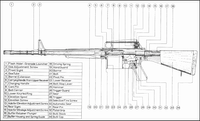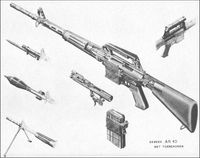The AR-10
Courtesy from www.ar10.nl for some of the photographs
The Armalite AR-10, the big brother of the iconic AR-15. The AR-10 is a 7.62x51mm battle rifle from Armalite. The rifle was designed by Eugene Stoner. The first AR-10 was introduced in 1956, it was a new highly innovative rifle at its time. It used lightweight materials and was far lighter than any rifle. The rifle also used a newly designed gas system.
The first AR-10 prototypes came out in 1955, during that time, the U.S. Army was holding trials for new rifles to replace the M1 Garand. Armalite submitted multiple prototype rifles to the trials.
The prototype rifles used a aluminum/steel composite barrel which was something new and unproven, and later during the trials, the barrel did burst (all later AR-10’s used normal steel barrels), and the AR-10 was kicked out of the trials. The U.S. Army later adopted the M14.
In 1957, Armalite sold a 5 year manufactering contract to Artillerie Inrichtingen, Zaandam, The Netherlands. Staatsbedrijf Artillerie Inrichtingen was the Dutch state arms manufactering company. From 1957-1960 A.I. produced ~10,000 rifles.
A.I. did continue development for the rifle making often small changes. The AR-10 was not successfull when it came to sales, only small orders were made. The rifle was trialed by many other nations but with little success.
AR-10’s were sold to Bangladesh, Brazil, Cuba, Finland (trials), Guatemala, India (trials), Italy, Myanmar, Nicaragua, Portugal, Romania, Sudan, West-Germany (trials), The Netherlands (trials) and the Dutch airline KLM.
Although not successfull regarding sales, its still one of the most influental rifles ever. There are many modern variants of the AR-10 being in use by militaries today as a DMR or sniper rifle (M110/SR-25). And the U.S. Army even adopting a new rifle heavily influenced by it.
In 1964, Armalite came up with the AR-15, a AR-10 scaled down to chamber the .222, .223 and 5.56x45mm round. Which was later adopted by the U.S. military as the M16. The AR-15 is now one of the most or the most popular assault rifle in the word, being the backbone of many militaries and law enforcement units worldwide. And its only becomming more popular.
The AR-10 uses Stoners internal piston system and a multilug rotating bolt, similair to your everyday AR-15. Here is step by step how it bassicly works
1. The trigger is pulled, which allows the hammer to fall forward and it hits the firing pin, the firing pin hits the primer of the chamber round and it ignites it, firing the round.
2. The bullet is propelled forward and when it passes the gas port, some gas which propels the round is getting tapped of into the gas tube, the gas in the gas tube then enters the gas key and then into the bolt carrier of the rifle. The gas pushes against the rear of the bolt carrier and the gas ring (which is attached to the bolt), it then pushes the bolt carrier backwards, when the bolt carrier is back far enough, the left over gasses exit via ventholes of the side of the bolt carrier
3. When the bolt carrier moves backwards, the cam track in the bolt carrier forces the bolt and cam pin to rotate, which unlocks the bolt from the barrel (extension). The pressure levels in the barrel and chamber are low enough to open and the bolt and carrier move backwards
4. When the bolt and carrier move backwards, it ejects the spend round, resets the hammer and when moving forwards it picks up a new round from the magazine and chambers it. Recycling the firing process.
Design of the AR-10, early Dutch Artillerie Inrichtingen shown as an example.
Over the span of 3 years, alot of changes were made to the rifle giving it new features and improving others. Handguards were changed to sheetmetal ones with plastic/wooden forends. The charging handle later got a build in forward assist. The selector changed from semi - safe - auto to safe - semi - auto (todays standard). Adjustable gas blocks, ability to fire rifle grenades and alot of reinforcing to parts.
The early American AR-10's handmade by Armalite. These models were known as ''Hollywood'' models.
The X01 is the great grandfather. It is a tubular model with a lower receiver mounted on the bottom, it does use Stoners internal piston system. Some sources claim it is fed by M1918 BAR magazines, but i can not confirm this. Funny enough, were going back in time to slimmer smooth top rifles.
The X02 is the second prototype. It has a integrated optical sight mounted to it. The receiver seems to be made from stamped sheetmetal.
The X03, its going to look more like it. It has integrated carry handle which is present to all later AR-10's, uses plastic furniture and it has a side charging handle.
The 4th prototype and final model. This was the final Hollywood model. This rifle was tested by the U.S. Military, due to the weakness of the aluminum/steel barrel, the barrel burst and the rifle was kicked out of the trials. The same model was tested by the West-German military, designated the Gewehr 4 (G4).
The Dutch models. Made by Artillerie Inrichting in Zaandam, The Netherlands. Artillerie Inrichtingen (pronounced Artjerry Inrikhtingen) was the Dutch state arms factory. it was formed in 1679 and was the main arms producer for The Netherlands. A.I went defunct in 1983. A.I. made the beaumont rifle, the M.95 ''mannlicher'' and later the FAL and UZI(?).
In 1957 A.I. got a contract to produce AR-10 rifles for 5 years, during its production span it made improvements to the rifles and managed to get a few contracts. The AR-10 was also tested out by the Dutch Military, and after a long fierce contest between the AR-10 and FAL, the FAL was chosen and adopted in 1956. The Dutch military intended to field reserves/nationale guard units (Nationale Reserve) M1 Garands chambered in 7.62x51mm using AR-10 Garand magazines. Which gave the AR-10 a leap forward, but due to problems converting the M1's, that failed and few years later the FAL was chosen.
The first Dutch model already had a few changes to the rifle. Featuring a new barrel, muzzle device and carry handle. Not long after, A.I got a contract with Sudan to produce 2508 rifles. Which has no holes in the barrel shroud and features a brass unit mark on the stock
The First Dutch trials model was also not very different, small differences to the controls, a new buffer and it is able to fire rifle grenades which was a requirement for the Dutch military.
The second Dutch trials model (known as the transitional model) was when it came to looks a new rifle. It featured new handguards which are easily removable, it is held in with the delta ring, similair to the M16. It was easier to properly clean and mantain the rifle this way. On older AR-10 models you had to remove the gas block to clean the inside.
The carbine. The little shorty. The carbine was intended for Dutch armoured infantry units who needed a shorter rifle but with enough firepower. It was meant as a infantry rifle, not as a PDW or rear echelon weapon to replace the UZI. It borrowed the same features as the Second Dutch trials model. Only 20 got made.
The third Dutch trials model or the Portuguese contract model. The finalized AR-10. During the Dutch rifle trials, A.I. presented a new AR-10 model with more improved features to compete against the FAL. The same model got later sold to Portuguese paratroops, where the rifle was extremly well received and liked. The rifle saw action in Angola, Mozambique and East-timor, it was usage all the way untill 1975. Portugal ordered roughly ~5000 rifles. The rifles featured a charging handle with build in charging handle, adjustable gas block, plastic handguards covering the sheetmetal handguards, reinforced stock for firing rifle grenades, reinforced bolt and receivers. And the Dutch military prefered sling points on the left side of the rifle and this model featured a rear sling point on the stock.
Few more of Dutch made AR-10's
In the late 1950's, Finland wanted to replace their aging M39 Mosin rifles for something more modern and in the Soviet 7.62x39mm intermediate cartrdige. Multiple rifles were submitted to trials The Madsen LAR, Cetme B, Sig SG-510, M58 (prototype of the later RK-62) and the AR-10, and all of the rifles were rechambered to 7.62x39mm
The AR-10 used for the trials has some notable differences. The rifle presented was the short barreled/carbine variant, it had either 20 round propiertary magazines or 30 round standard AK magazines, it had a side charging handle inside of the carry handle and a flat carry handle. The M58 was chosen and later changed to RK-60 and finally the RK-62, which is to this day still the standard issue rifle. But in 2022, the Finnish army bought the Sako M23 rifle as the new sniper rifle (modern AR-10 variant)
In 1958, the Royal Dutch Airlines aka KLM (Koninklijke luchtvaart maatschappij) opened a new flight route to Tokyo through Anchorage (Alaska). In case of an emergency landing, KLM aircraft had survival gear specifically made for Polar terrain, including a Artillerie Inrichtingen made AR-10 battle rifle against Polar bears. This rifle was chosen because it was light weight (pretty important for airlines) and domestically made. In total 10 AR-10's were delivered to KLM.
The AR-10's which were sporter variant and had 16 inch barrels, the rifles were semi automatic only. And military feautures like a muzzle device and bayonet lug were not present.
The AR-10 LMG (not sure if classified as a light machine gun) was the belt fed machine gun variant of the AR-10. It had a heavier machine gun barrel and was easily and quick to remove. The machine gun was fed by belts or magazines. The machine gun had a imple bipod and could also be mounted on a tripod like a general purpose machine gun, alot of information about this model is unknown, maybe a topic for another time.
The AR-10 LSW was the variant meant for Dutch marines who needed a heavy barreled machine gun based of their infantry rifles (see it as a RPK). This variant was part of the Second Dutch AR-10 trials family of rifles. This rifle was together with other AR-10's tested in Dutch New Guinea (now part of modern day Indonesia). The AR-10 was rejected and the FAL was chosen, and the Dutch marines got fielded heavy barreled version of the FAL. And in 1995, when the Dutch militaty adopted the C7 family of rifles, Dutch Marines got a similair version of the rifle issued but modernized and chambered in 5.56x45.
The AR-102, a civillian model of the military AR-10. Alot is unknown about this variant. It is similair to the 2nd Dutch trials AR-10 but it is semi automatic only, features no bayoney lug and it has a slanted magazine well. The rifle is seen with 10 round magazines.
AR-10 with attachments. The Delft scope, which also later present on Colt AR-15's was a 3x25 optic which can be mounted on the carry handle. The same scope later continued production with slight changes to be mounted on the FAL, the scope was designated the KRR62 (kijker recht richt 1962/ Scope straight aim 1962), which was fielded to Dutch Sharpshooters. The scope is very rare and wanted on the US civillian market.
The AR-10 is not dead, its more alive than ever...
Special thanks to www.ar10.nl for allowing me to use very nice photographs of AR-10'', for more information, check them out.
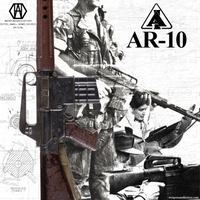

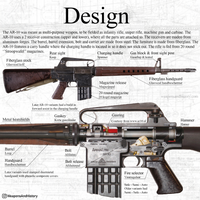

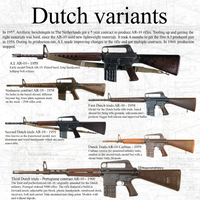
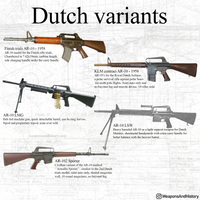
%20Instagram.png/picture-200?_=187615de078)
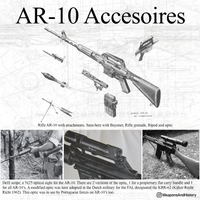
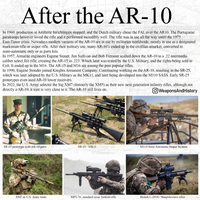

%20Instagram.png/picture-200?_=18761612c38)
